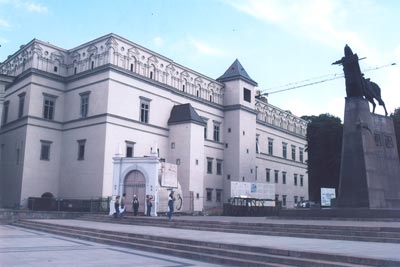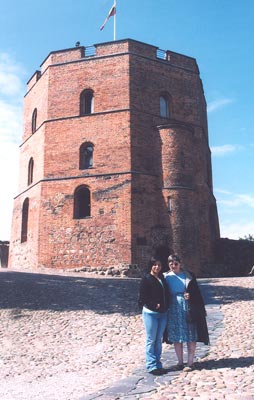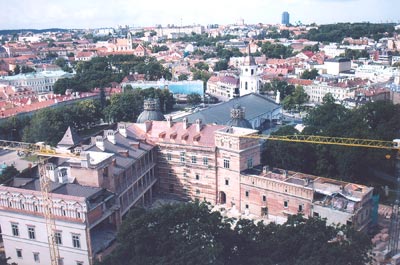Vilnius: a royal palace reborn
This item appears on page 75 of the September 2008 issue.
by Julie Skurdenis
Lithuania is revving up for a grand celebration. The year 2009 will mark the 1,000th anniversary of this Baltic nation. It was in 1009 that the country was first mentioned in a written source, a German manuscript called the Quedlinburg Chronicle (in Latin, Annales Quedlinburgenses).
July 6th is celebrated in Lithuania as Coronation Day, the day on which Mindaugas, the country’s only king, was crowned in 1253 (subsequent Lithuanian rulers were called grand dukes). July 6, 2009, promises to be a special year’s most special day. It’s when a long-anticipated event will take place: a royal palace will be reborn.
On each of my visits to Vilnius, Lithuania’s capital, I barely check into my hotel before I head over to the edge of the Old Town to see what progress has been made on the Royal Palace since my last visit.
Over the course of 15 years and seven trips to Lithuania, I have been present at all stages of that rebirth: from empty spot to open pit with archaeologists extracting artifacts to construction of a palace resembling the one that stood there 500 years ago. On my last trip, in July 2007, the outer shell of the palace stood almost complete. Only the interior needed to be finished and furnished.
First castle
Vilnius became the capital of Lithuania in 1323 under Grand Duke Gediminas. A castle was built on a hill where two rivers, the Neris and the Vilnia, meet. Defensive towers, walls and a castle hall crowded the small space atop this hill.
Gradually, at the base of the hill, a Lower Castle also developed. It was much more extensive than the castle atop the hill. Here, too, were defensive towers and walls, but there also were arsenals and churches and, at its heart, a palace.
In the 14th century, during the long reign of Grand Duke Algirdas (1345-1377) Lithuania grew to become one of the largest and most powerful countries in Europe, with territory stretching from the Baltic Sea to the Black Sea. It encompassed portions of what is now Poland, Russia, Belarus and Ukraine.
A Renaissance palace
As the country expanded, so did the Royal Palace at the foot of the hill, from wooden residence to a Gothic stone structure to a grand Renaissance palace which began to take shape during the reign of Grand Duke Alexander Jagiellon (1492-1506), who was married to Helena, a daughter of Russian Czar Ivan III.
This Renaissance palace was completed in the reign of Sigismund the Old (1506-1548), who was married to Bona Sforza of the powerful Milanese family. It is probable that she brought from Italy ideas of what a proper Renaissance palace should be. Her son, Sigismund Augustus (1548-1572), expanded this Renaissance palace.
The 16th century was the Royal Palace’s “golden age.” In 1610, however, fire ravaged the palace, and in 1655 occupying Russians sacked the palace and all but destroyed it. It stood neglected for another 146 years until Czarist troops razed it in 1801.
The spot where the palace once stood, between the Cathedral on one side and Gediminas Hill on the other, remained empty until 2002 when archaeological excavations began. Layer upon layer of palace history was unearthed as well as over 300,000 artifacts, some of them more than 700 years old from the earliest palace on this site.
Excavation has been followed by reconstruction. The Renaissance palace that has emerged is based on surviving 18th- and 19th-century drawings and illustrations that have served as architectural blueprints. The completed palace will look as the Royal Palace of the 1500s must have looked, with four buildings enclosing an irregularly shaped quadrangular courtyard.
Artifacts on display
Artifacts from the archaeological dig probably will be eventually displayed in the Royal Palace. A generous sampling is now on display until Dec. 31, 2008, in the nearby Applied Arts Museum (Arsenalo str. 3A); hours are 11 to 6 Tuesday to Saturday and 11 to 4 Sunday.
Until the Royal Palace is restored and open, you can visit the Upper Castle on Gediminas Hill. A tower of this castle has been turned into a small museum and there are wonderful panoramic views over the entire Old Town from the tower roof.
You can either walk up the hill, a steep 15-minute climb, by a pathway that begins close to the Royal Palace or take the new funicular on the opposite side of the hill next to the new Archaeology Museum, itself a “must see.”
The Upper Castle is open 10 to 7 daily during the summer season and 10 to 5 Tuesday to Sunday the rest of the year. There is a small admission charge.
More to see in Vilnius
To sample more of Vilnius’ 700-year-long history, you can do no better than take a leisurely stroll through the Old Town, one of the largest in Eastern Europe yet extremely doable on foot (in fact, don’t do it any other way).
Highlights not to miss are the four-century-old Vilnius University complex of buildings arranged around a series of 13 courtyards; the Presidential Palace that housed both Czar Alexander I and Napoleon in 1812 (not at the same time!); the Cathedral, with origins stretching back to the mid-13th century; the stunning small Gothic St. Anne’s Church and its very close neighbor, the 15th-century Bernardine Church; the 17th-century Russian Orthodox Church of the Holy Spirit; the Baroque St. Casimir’s Church, named after the patron saint of Lithuania, Prince Casimir Jagiellon; the little Gothic gem of a church, St. Nicholas, built in 1320 by German merchants before Lithuania converted from paganism to Christianity later in the 14th century, and, to cap it all off, at the opposite end of the Old Town, the 16th-century Gates of Dawn, once part of the town’s medieval city walls. Leave time to explore Old Town courtyards and winding side streets.
If you go. . .
I love the Shakespeare Hotel (Bernardinu str. 8/8; e-mail info@shakespeare.lt or visit www.shakespeare.lt) because of its charm, its Old Town location and the traditional English breakfast they serve (or you can opt for American-style scrambled eggs and bacon or Lithuanian-style blini served with red caviar, among choices offered).
The Shakespeare is a small boutique hotel with rooms named after famous authors. Each room is unique (no cookie-cutter rooms here) and beautifully decorated and includes books by the author after whom it is named. Many of the rooms offer glimpses of the Cathedral, the Upper Castle or one of the churches for which Vilnius is famous.
Prices range from $215 to $272. The Royal Palace is a 5-minute walk away.
There are two companies to consider in planning a trip to Lithuania: Vytis Tours in New York (phone 800/778-9847 or 718/423-6161, www.vytistours.com) and Lithuanian Tours in Vilnius (phone 370 5 2724154, e-mail contact@lithuaniantours.com or visit www.lithuaniantours.com).
I’ve used both companies often for flight arrangements, hotels and car rentals and for trips to the neighboring Baltic countries Estonia and Latvia as well as Belarus.



